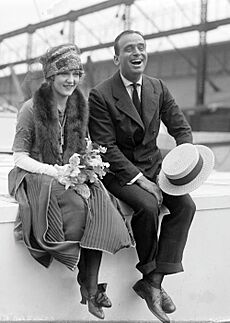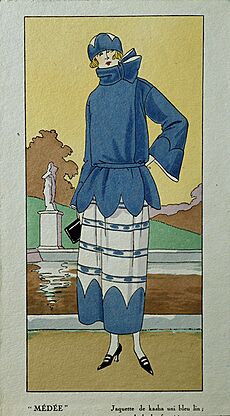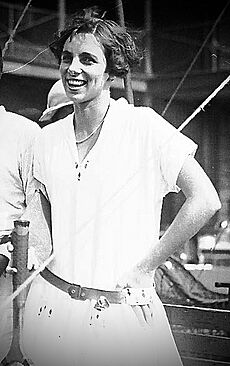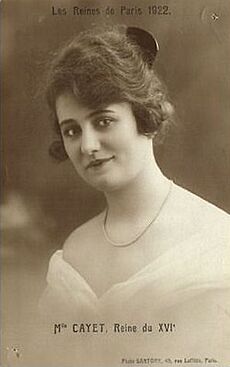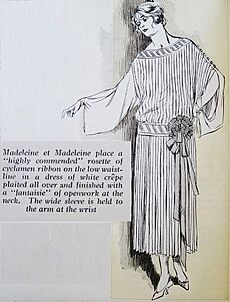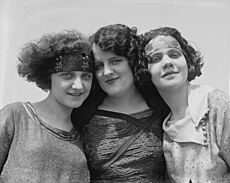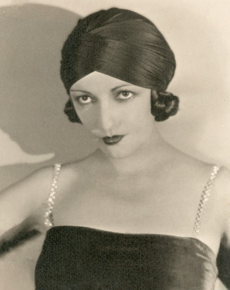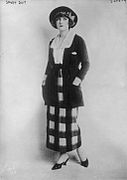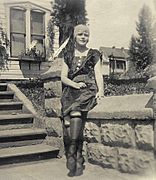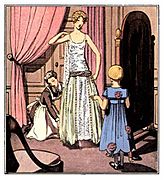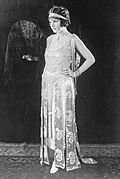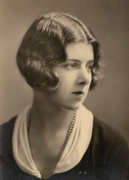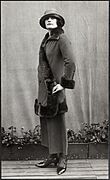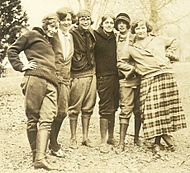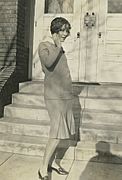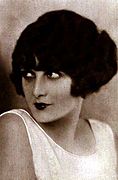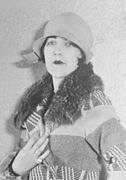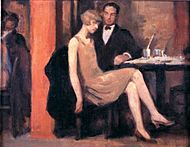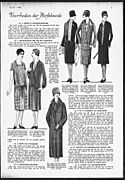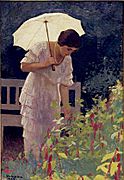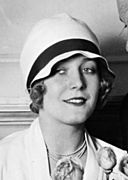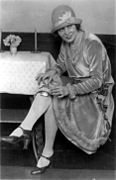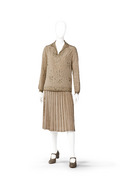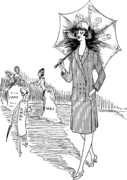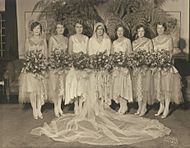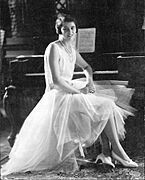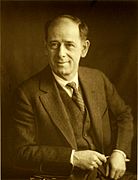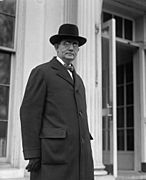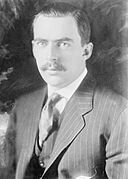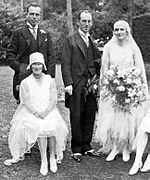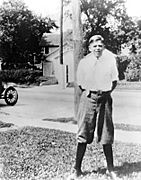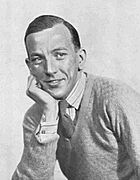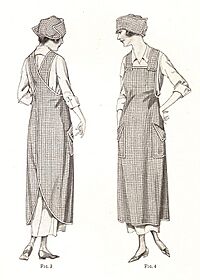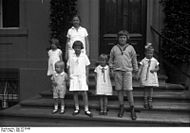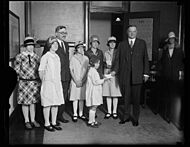1920s in fashion facts for kids
Western fashion in the 1920s saw a big change. Women's clothing became much freer. It moved away from the strict styles of the past. Clothes were looser, showing more of the arms and legs. This trend started about ten years earlier. Men also began wearing less formal clothes. Sportswear became popular for everyday wear. This was a first for mainstream fashion.
Fashion in the 1920s was greatly shaped by women. They challenged old ideas about how women should dress. Many traditional outfits were hard to move in. For many, fashion showed women's new freedom. It also showed a focus on slim body shapes.
The 1920s had two main fashion periods. Early in the decade, changes were slower. People were hesitant to wear the new, more revealing styles. After 1925, people really embraced the styles. These are the looks we now connect with the Roaring Twenties. These styles lasted until the worldwide economic depression in 1931.
Contents
A Look at the 1920s Fashion Scene
After World War I, the United States became very successful. It also became a major player on the world stage. People felt hopeful after the war ended. Social rules became more relaxed. More women started working than ever before.
Life was changing in many ways. Fashion was no different. Women working and voting made them feel free. Fashion became easier to wear and more practical. It also looked more masculine. This led to the idea of "The New Woman." Women who wore these new styles were often called "Flappers." The tight corset, which made the waist tiny, was no longer popular.
New fabrics and ways to fasten clothes changed fashion. Cotton and wool were common fabrics. Silk was expensive and desired for its luxury. In the late 1800s, "artificial silk" was made in France. It was later called rayon. Rayon stockings became popular. They were a cheaper choice than silk. Rayon was also used for some underwear.
Before the 1920s, clothes often used buttons and laces. But in this decade, metal hooks and eyes were developed. This made fastening clothes easier. Hooks and eyes, buttons, zippers, and snaps were all used.
Better production methods made clothes affordable. Working families could now buy stylish outfits. The average person's fashion sense improved. Working-class women moved from farms to cities. They wanted modern clothes for their new jobs. They copied wealthier women's styles. They wore simpler versions of day suits. This modern look fit their new jobs. Many became typists or telephone operators.
Even with simple designs, the 1920s had luxury. High-end designers used expensive fabrics. These included silk, velvet, and satin. Department stores sold cheaper versions. These were made from new synthetic fabrics. Mannequins became common. They showed shoppers how to wear and accessorize new fashions. The modern fashion cycle started in the 1920s. It still shapes the industry today. Designers liked separate pieces. They used new fabrics like jersey. These could be mixed for work or fun activities. People went to films, theater, or car rides.
Women's Fashion Trends
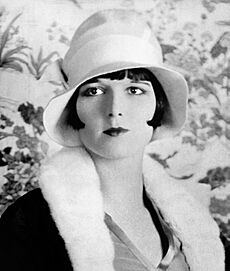
Paris was the center of fashion. It set trends for Europe and North America. Women's fashion was all about freedom. Women wore dresses every day. Day dresses had a "drop waist." This was a belt worn low on the hips. Skirts hung from the ankle to the knee, never above. Daywear dresses had sleeves. Skirts were straight, pleated, or tiered. Hair was often bobbed, giving a boyish look.
Clothing changed as women's roles changed. This was especially true for new fashion ideas. Older, wealthy women still wore traditional dresses. But sportswear became very popular. It was worn by younger, forward-thinking women. This was the biggest change after the war. The tubular dresses of the 1910s changed. They now had shorter skirts. The most famous look of the Roaring Twenties was the "flapper" style.
The straight-line dress, called a chemise, was popular. It was worn with a close-fitting cloche hat. This became the everyday uniform. Women "bobbed" their hair short. This helped it fit under the popular hats. It was a big change at first. But it was standard by the end of the decade. In France, the bobbed hairstyle was controversial. There were stories of families rejecting women for cutting their hair. In Western countries, women gained the right to vote. This may have helped lead to the social changes of the 1920s.
No one knows for sure who started the bob hairstyle. Some say French designer Coco Chanel cut her hair in 1916. Others point to Joan of Arc, a symbol of female strength. The novel La garçonne by Victor Marguerite also played a role. It was about a woman living a free life. Low-waisted dresses with full hems allowed women to dance. They could "kick up their heels" in new dances like the Charleston. In 1925, "shift" dresses appeared. They had no waistline. By the end of the decade, dresses had straight tops and collars. Pleats at the bottom of the top were popular. Knife-pleated skirts were also in style. Their hem was about one inch below the knee.
Art movements like surrealism influenced fashion. Elsa Schiaparelli was a key Italian designer. She was inspired by "beyond the real" art. She put these ideas into her designs.
Women had specific clothes for morning, afternoon, and evening. Early in the decade, wealthy women changed clothes often. Afternoon or "tea gowns" were less fitted. They had long, flowing sleeves. They were decorated with sashes or bows. The term "cocktail dress" was created in France. It was for American customers. The cocktail dress came with a matching hat, gloves, and shoes. It was special because it could be worn for many events. With the right accessories, it worked from 3 pm to late evening. Evening dresses were usually longer than tea gowns. They were made of satin or velvet. They were decorated with beads, rhinestones, or fringe.
Headbands and Accessories
Headbands were called bandeaus. They were worn with formal evening dresses. This was popular until 1925. Styles included brain binders, feather headbands, and skullcaps.
The Cloche hat was a key accessory. In 1926, Vogue magazine said "The Bob Rules." This was nine years after dancer Irene Castle cut her hair. This trend inspired a 1920 short story. It was by F. Scott Fitzgerald, called Bernice Bobs Her Hair. Vogue also featured many articles about it. The bob hairstyle fit the loose, straight fashion of the time. Vogue said this new haircut helped the hat business. New haircuts meant new hat styles. So, there was a big demand for hats. The cloche hat and the bob were perfect together.
Jewelry was less flashy. It became simpler and used more natural shapes. The Art Nouveau movement (1890-1910) inspired many designs. It brought natural forms and geometric shapes. "Clean lines were inspired by industrial machines." The Bauhaus movement was a key influence. It believed that "form follows function." Contrasting textures and colors were also popular. For example, diamonds were set against onyx. Amethysts were placed next to coral and jade. Even with new geometric styles, the long rope pearl necklace was key. It was a popular fake piece. It was cheap and a basic item for women. "Jewelry design between the 1920s and 1950s was new and glamorous." Sharp, geometric patterns celebrated the machine age. Exotic designs from the Near and Far East showed that jewelry was international.
Shoes were finally visible in the 1920s. Before, long clothes covered them. So, shoes were not a big part of fashion. Now, everyone saw shoes. They became important in the 1920s. Women had shoes for all events. There were house shoes, walking shoes, and dancing shoes. There were also sporting shoes and swimming shoes. The shoe industry grew a lot. It changed how we buy shoes today. Shoes were made in standard sizes. You could order them from catalogs or buy them in stores.
Early in the 1920s, Mary Janes were still popular. But they led to many new shoe designs. The T-strap heel was a Mary Jane variation. It had the same base. But it added a strap around the heel. This strap went down to the top of the shoe, looking like a "T." Also, "The bar shoe became popular." It fastened with a strap and one button. It was worn with the new short skirts. It was practical for energetic dancing.
Jazz Music's Influence on Fashion
"The Jazz Age" was a term made popular by F. Scott Fitzgerald. It described how popular jazz music was in the 1920s. Jazz music and dance marked a shift. They moved from old Victorian values to a new, modern society. Jazz gained popularity because it felt exciting and new. It came from African-American roots. Its soulful rhythm was very appealing. The music had a strong effect on young people. It was seen as the heartbeat of the 1920s.
New music brought new dances. Jazz dances like the Charleston replaced the slow waltz. Paul Whiteman helped make jazz dance popular. Jazz music and dance even led to the term "flapper." Flappers were new, socially unconventional women. When dancers did the Charleston, their fast foot and arm movements looked like a bird flapping. Jazz music made people want to dance. And dancing made people want new clothes. Women especially needed clothes that let them move freely.
Dances like the Charleston and the Black Bottom changed evening wear. These jazz dances were very energetic. Dress and skirt hems became shorter. This allowed the body to move more easily. Also, decorations on dresses, like fringe, swung and jingled. They moved with the body. Shiny and fancy fabrics reflected light. They moved to the rhythm of jazz music and dance. Jazz music had a flashy influence on fashion. But it also kept clothes practical and functional.
Jazz also influenced textiles. Jazz and dance patterns appeared on fabrics. These new designs included uneven repetitions. They also had linear geometric patterns. Many U.S. textile patterns showed jazz bands. They also showed people dancing to jazz. The "Rhapsody" print from 1925 shows a jazz band. It looks like polka dots. Textiles not only showed jazz motifs. They also had designs based on the rhythm and sound of jazz music.
The Boyish Look
Undergarments changed after World War I. They aimed for a flatter chest and a more boyish shape. Corsets became less popular. The new boyish look was achieved with girdles and bust bodices. New pieces included thin camisoles and cami-knickers. They were mostly made from rayon. They came in soft, light colors. This was so they could be worn under see-through fabrics. Young flappers liked these styles of underwear. They allowed more freedom of movement. They were also more comfortable for dancing to fast jazz music. In the mid-1920s, all-in-one lingerie became popular.
For the first time in centuries, women's legs were seen. Hemlines rose to the knee. Dresses became more fitted. A more masculine look became popular. Short hairstyles like the bob cut, Eton crop, and Marcel wave were in style. This fashion showed a free-spirited and modern attitude.
Coco Chanel was one of the first women to wear trousers. She also cut her hair short and rejected the corset. She was perhaps the most important woman in 20th-century fashion. Chanel did much to free women's fashion.
Jean Patou, a new French designer, made two-piece outfits. These were sweaters and skirts. They were made of luxurious wool jersey. His morning dresses and sports suits were successful. American women felt his clothes fit their active lives.
At the end of the 1920s, Elsa Schiaparelli combined ideas. She mixed classic Greek and Roman designs. She also added the modern need for free movement. Schiaparelli wrote that ancient Greeks "gave to their goddesses... the serenity of perfection and the fabulous appearance of freedom." Her own designs created elegant, simple evening dresses. Moving away from the chemise, her clothes showed awareness of the body.
- Style gallery 1920–26
-
Actress Norma Talmadge in formal wear, early 1920s.
-
Greta Garbo in French fashion, autumn 1923
-
Greta Garbo in French fashion, autumn 1923
-
Actress Aileen Pringle wearing a cloche hat and boldly patterned coat, 1926.
-
Actress Alice Joyce in a straight dress with a sheer beaded overdress, 1926.
- Style gallery 1927–29
-
Actress Vilma Bánky wearing cloche hat, 1927.
-
Coco Chanel wearing trousers and a sailor's jersey, 1928.
-
Woman hiding a hip flask tucked in her garter belt during Prohibition, late 1920s.
-
A French aristocrat in Paris wearing a silk dress, Autochrome Lumière process dated 1928.
Men's Fashion Trends
Men's fashion in the 1920s also had two main periods. Throughout the decade, men wore short suit jackets. The old long jackets were only for very formal events. In the early 1920s, men's jackets had very high waists. They often had belts. Lapels on suit jackets were not very wide. They were often buttoned up high. This jacket style was likely influenced by military uniforms from World War I. Trousers were quite narrow and straight. They were worn short, so socks often showed. Trousers also started to be cuffed at the bottom.
By 1925, wider trousers became popular. These were known as Oxford bags. Suit jackets went back to a normal waist. Lapels became wider and often peaked. Loose-fitting sleeves without a taper also appeared. In the late 1920s, double-breasted vests became fashionable. They were often worn with a single-breasted jacket. Men had many sweaters and short trousers (knickers) for sports. For formal daytime events, a morning suit was common. For evening wear, men preferred the short tuxedo. The tail coat was seen as old-fashioned.
Men's fashion also became less strict. Men liked short jackets with two or three buttons. They preferred them over long tailcoats. Pinstriped suits were also popular. Casual wear for men often included knickers. These were short pants that reached the knee. The most formal men's suit was black or midnight-blue. It had a worsted swallow-tailed coat with satin trim. Matching trousers had wide braid or satin ribbon down the sides. A white bow tie, black silk top hat, and white gloves completed the look. Patent leather Oxford shoes, a white silk handkerchief, and a white flower boutonnière were also worn.
The tuxedo vest could be black or white. But unlike the formal white tie, tuxedo ties were always black. Men usually wore the same accessories with a tuxedo as with a formal suit. But instead of top hats, they wore dark, dome-shaped hats called bowlers. Just like women, men had specific outfits for certain events. Tuxedos were right for the theater, small dinner parties, and dining out. In the early 1920s, most men's dress shirts had a narrow neckband. It had buttonholes in the front and back. But by the mid-1920s, many men preferred shirts with attached collars. These were softer and more comfortable.
Men's Hats
Men's hats often showed their social class. Upper-class men usually wore top hats or a homburg hat. Middle-class men wore a fedora, bowler hat, or a trilby hat. In summer, a straw boater was popular for upper and middle-class men. Working-class men wore a standard newsboy cap or a flat cap.
- Style gallery
-
Photographer Clarence Hudson White, c. 1920.
-
Ronald Reagan as a teenager wearing knickerbockers, 1920s.
-
British playwright and actor Noël Coward in a jumper
-
Man wearing a Panama hat and buttoned waistcoat, 1927.
Fashion Influences and Trends
In the 1920s, keeping up with fashion became very important. Middle-class Americans wanted to express themselves through new things. Buying new clothes, appliances, or cars showed how successful you were. Many Americans tried hard to avoid looking old-fashioned. They also didn't want to seem unable to afford new, stylish products.
For women, face, figure, hair, posture, and grooming became key fashion factors. Cosmetics became a huge industry. Women felt proud to care about their looks. It was a sign of self-worth. They no longer wanted a natural look. For evenings, a smoky eye with long lashes was popular. Rosy cheeks and a bold lip were also in style. To make eyes stand out, Kohl eyeliner became popular. This was the first time eyeliner was widely known. Women also started wearing foundation and pressed powder. With the invention of swivel lipstick, bright lip colors rose in popularity. Women applied lipstick to create a "cupid's bow" and "bee stung" look.
Glamour became a major fashion trend. This was due to the movie industry. Famous female movie stars had a big influence. Style at many social levels was shaped by these larger-than-life stars. For the first time, fashion trends came from more than one source. Just like today, people in the 1920s looked to movie stars for fashion ideas. Women and men wanted to copy the styles of Hollywood stars. These included Louise Brooks, Greta Garbo, Rudolph Valentino, and Clark Gable.
Work Clothes
For working class women in the 1920s, tailored suits were popular. They had a straight, simple cut. Throughout the decade, skirt lengths changed. They went from knee to ankle at different times. This affected the style of tailored suits. Rayon, an artificial silk fabric, was common for working-class women's clothes.
For working-class men, suits were popular. The suit would change based on the job and season. These suits often had high lapels. They were made of thick wool before central heating was common.
-
An apron and dutch cap, 1922
Children's Fashion
Children's fashion became more stylish and comfortable in the 1920s. Clothes were made from cotton and wool. They were no longer made from silk, lace, and velvet. Clothes were also made stronger. This was so they could stand up to play. In earlier decades, many layers were worn. But in the 1920s, fewer layers became the norm.
For girls, clothing became looser and shorter. Dresses and skirts were now knee-length and loose. Shoes were made of canvas. This made them lighter and easier to wear.
For boys, knee-length trousers were worn all year. They were worn with ankle socks and canvas shoes. Pullovers and cardigans were also worn when it was cooler.
See Also
- Cosmetics in the 1920s
- Roaring Twenties
- Flapper
- Interwar period


